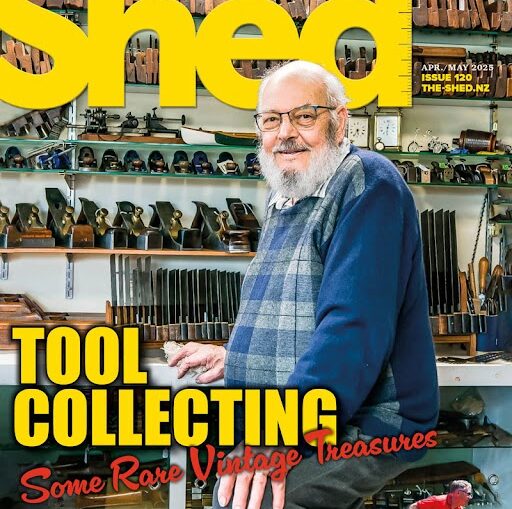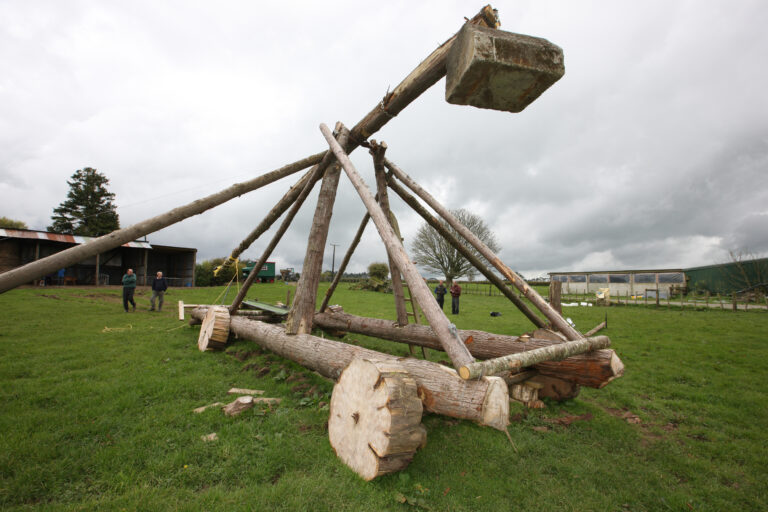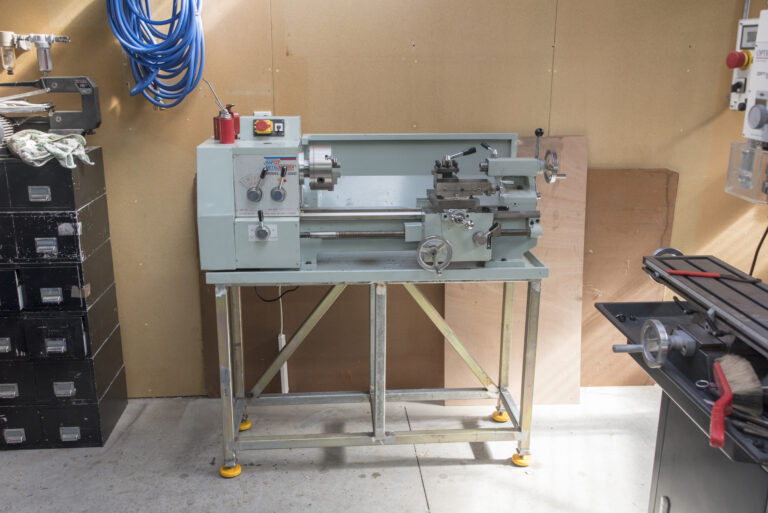From drum
To furnace
A sturdy furnace is essential for melting metal and backyard casting.
SOME TIME ago I decided to resurrect an old three-wheel bandsaw from wood-cutting to metal-cutting. This entailed changing the blade and, more importantly, changing its cutting speed. I sat down and worked out a simple system involving the change of a pulley for a larger one. This seemed like a simple task, but after a search amongst the detritus of my workshop I failed to find anything suitable. I will admit that this scenario is not rare in my workshop as I have looked for particular-sized pulleys in the past and have had to embark on a trip to the local hardware store to find the right size. Unfortunately, the range they have on offer does not always fit the bill. I then have to cruise the few second-hand dealers that I occasionally frequent.
On this particular occasion I mentioned my predicament to a friend who said, “Why don’t you make one yourself?” This set me thinking as I have a lathe and a reasonably well-set-up workshop. After much deliberation, I decided to cast a blank and then turn it to finished dimensions on the lathe. An evening searching the Internet resulted in a basic concept of what I needed to cast my blank. I have had casting experience in the dim and distant past as an art student, but since then not a lot.
The basic approach to any project like this is to ask yourself “What do I want to achieve?” then work backwards from that point.
Burner parts list
500mm 5/16” copper tubing
300mm 25mm wrought, medium galvanized pipe.
5/16” x 1/8” BSPM male connector.
Binzel MB24/36 1.0mm MIG tip.
25mm x 75mm brass plumbing nipple.
End cap for above.
2M LPG hose and fi ttings to suit your regulator.
Brass nipple and tail connector to join copper pipe to LPG hose.
100mm thin walled pipe to act as air control sleeve.
6mm x 30mm Hex bolts.
Port cut
Angular structure of bricks
Insulating mix
Ramming in mix
Melting Metal
The essence of melting metal is to have a container for the molten metal and an enclosure to retain the heat that you apply to the container. The temperature required to melt aluminium (660°C) is not great and anyone who has seen The World’s Fastest Indian will know that it can be done reasonably easily. In the interests of safety and future projects, I built a more robust setup that is dedicated to the melting of aluminium but also capable of melting bronze and brass with a change of crucible.
This project covers three topics. Building of a small gas-fired furnace, constructing a simple LPG burner and, in a follow-up article, casting and finishing an aluminium pulley wheel. Once these are completed, there will be no end to the objects that you will want to design and cast from scrap aluminium. The process is reasonably straightforward and can easily be modified to cope with brass and bronze.
Furnace
The choice of furnace size is governed, primarily, by the size of crucible. This in turn is governed by the amount of material you wish to melt. The other important considerations are the amount of space you have and the amount you wish to spend. For the purposes of this exercise I have based my furnace on a 44-gallon oil drum. This is cut at the 2/3 mark, the larger portion making the body of the furnace and part of the smaller portion forming the lid. (See panel: Cutting An Oil Drum Safely)
Because of the final weight of this furnace, it is advisable to construct it in situ on a concrete pad. The frame for the lifting mechanism and the furnace are embedded in the concrete to maintain alignment. A bed of sand approximately 75mm deep is spread on top of the concrete pad. This sand bed copes with spills and forms a fireproof barrier to the surrounding area. Molten aluminium landing on concrete will explode violently and send hot material and concrete lumps flying everywhere…so take care.
The drum is lined with insulating bricks and then fire bricks. The insulating bricks are of the type used in night storage heaters. However an insulating layer could also be cast using a vermiculite/ sand/cement mix. The object of the furnace chamber is to allow the flame jet to circulate around the crucible in a cyclone action, finally exiting from the top hole. To ensure the crucible heats well, it is raised up from the bottom of the furnace and sits on a firebrick fixed in position with refractory cement. The aim is a compromise between having enough room around the crucible to manoeuvre tongs etc and a small enough chamber so as not to waste heat.
Drum concreted Note 50mm abve rim
Lid filled with refractory mix
Drum centre (detail)
Scaffold clamp hinges
Welding counterweight
Bending lifting arms
Drum
The base of the oil drum, after it has been cut, will need a hole in it to accommodate the burner port. Draw a circle of 100mm diameter approx 200mm from the base and drill a series of small holes around its perimeter. After you knock the hole out with the aid of a sharpened chisel, the edges can be filed reasonably smooth. Line the base of the drum with 100mm of refractory concrete setting a firebrick standing on end in the centre. This will provide the base to stand the crucible on.
The drum is then lined with lightweight insulating bricks or a 75mm thick layer of insulating mix comprising two (2) parts coarse vermiculite, four (4) parts sand and one (1) part cement. This is mixed to a ramming consistency and placed in handfuls around the inside of the drum. A temporary former made from sheet tin, thick cardboard or thin ply can be taped into a cylinder with duct tape and placed in the centre. After you extract the former, you place the firebricks to form the furnace lining and ram the remaining insulating mix into the space between the bricks and the drum. It isn’t necessary to ram too hard but merely enough to ensure there are no large gaps.
This rammed mix is stopped about 50mm below the top of the drum and the remainder plus another 50mm is filled with refractory concrete. To achieve the extra 50mm, I tied an 80mmwide strip of 3mm ply around the drum and levelled it prior to filling. This extra 50mm of refractory mix provides the mating surface for the lid section.
You need to allow for the burner port when you place the insulating layer and firebricks. Cutting the port to shape is not the easiest of tasks. I ended up cutting away a larger area than required and then moulding the port around a tube constructed from stiff card. This actually works to your advantage, as any subsequent damage to the burner port can easily be patched.
The “angular” structure of the furnace formed by the bricks is good for creating a mild turbulence. It gives the bricks more time to absorb the heat and therefore store it. This provides an atmosphere inside the furnace that will prevent the melt from chilling too quickly once the gas supply is turned off. That is essentially the main body of the furnace done. Now all you have to do is make the lid and One-handed counterweight system. lifting mechanism.
One-handed counterweight system
Plug for lid hole
Burner assembly
The lid
The lid is the remainder of the oil drum cut in half and fi lled with refractory mix, except for a 100mmdiameter hole in the middle. As this piece of the drum has neither a top nor a bottom, some reinforcing rods will be necessary. Depending on the type of drum you use, you may have to weld or drill the ring to hold the reinforcing. Some drums have corrugated rings around them and these will provide enough key for the refractory mix. The hole in the middle is for checking the contents of the crucible without lifting the lid, so what diameter you use is not critical. To provide a form for the hole, I used a paint tin wrapped in layers of newspaper. When it was removed, the hole needed minimal tidying up.
The lid is heavy, approximately 56kg, and needs to be lifted out of the way when you place or remove the crucible. It also needs to be replaced quickly so as not to lose valuable heat. As it is very, very hot this is not a “grab-it-with-atowel- in-your-bare-hands” job. Many ingenious devices have been developed over the years to achieve the required results, so mine is merely a step in the stairway of progress.
I opted for the counterweighted system as it can be operated with one hand and places the lid accurately all the time. In order to operate it you have to stand away from the furnace, so that provides a built-in safety feature. I repeat that this is only one solution among many and this is the area where Kiwi ingenuity will come to the fore.
An important aspect is that you use what materials you have. No point in buying steel and following my lifting mechanism to the letter if you have an alternative gizmo in the corner of you shed that, with minimal adaptation, will do the job equally if not better. (I look forward to seeing some alternatives).
Lifting mechanism
The frame of the lifting mechanism is made from 60mm x 10mm mild steel. The ends are drilled with 10mm holes. I cold-bent them with the aid of a simple bending jig. The jig was constructed from two short lengths of 12mm rod welded to a length of angle iron. This was held in the vice, the steel bar positioned between the rods and then bent by leaning against it. If the effort required becomes too great, simply reverse the bar or slip over a larger longer length of rectangular tubing to increase the leverage.
The shape of the arms will vary depending on what type of counterweight you employ. When you are satisfi ed with the shape of the fi rst arm, use it as a template for the second. The hinge mechanism is a length of scaffold pipe cut into three pieces and slipped onto another pipe to provide a slip fi t. Joining the frame to the hinge mechanism is a crucial area in the design. I opted to attach it with scaffold clamps. These are easily available and simple to use yet provide supreme strength to the whole project. You may choose to weld but this is a crucial area and your welding will have to be very good to avoid slippage. The scaffold clamp method also allows for fi ne adjustment when you align the lid to the base.
The counterweights I used are off-cuts from a factory that makes gears, but any suitable scrap will suffi ce. Lead is another alternative and will make a smaller counterweight owing to its greater specifi c gravity. There is no earthly reason why you could not use a bucket of sand or stones. It is, after all, a means of reducing the effort required to lift the lid. The average weight of the lid, if the instructions are followed, will be in the region of 56kg. This is a reasonably heavy load and greater than can be handled with one hand.
The furnace built for this project had a lid that was capable of being lifted with minimum pressure from one hand. If the length of the arm is longer on the weight side, the weights can be less than the weight of the lid. (All those physics lessons you attended in school are now coming into use!) The aim of the exercise is to create a mechanism that will easily lift the lid with the effort of one hand on the arm, and that can be lowered gently, rather than crash down.
A locking mechanism in the up-position may be necessary if you are the only person around, although I strongly suggest that this is NOT an activity that is best done solo. Always have someone else there in case of splashes, spills etc. I incorporated a length of scaffold pipe on the frame and when the lid is in the UP position it stays there quite happily with the counterweight holding it. Your design will again depend on the counterweight system used. Kiwi ingenuity will prevail.
The last and fi nal piece of the furnace is the plug for the hole in the main lid proper. This is merely a circle of castable refractory concrete with a wire loop embedded in it so it can be lifted to one side with a rod and replaced at will.
There you have it…a solid smelting furnace that will give many years of service and didn’t cost the earth.
The burner
The principle of an LPG burner is that the gas, under pressure, is forced through a very small orifice and as it expands sucks air into the combustion chamber and is ignited. As LPG is under a considerable pressure in the tank, all that is required is to open the valve and via a suitable regulator feed it into a length of steel piping, which has controllable inlets for air. These crude aspirating burners are cheap to construct and reasonably simple to use. They do require constant supervision as, without ignition jets and cut-off solenoids, they are a potential danger should the flame go out. Once the interior of the furnace is glowing red, this ceases to be a major problem as the gas will easily re-ignite. LPG is a wonderful fuel but needs respect and attention at all times.
I used a 300mm length of 25mm ID galvanized pipe drilled with 12mm holes to provide air slots. A sleeve of tube that was slightly larger than the burner tube provides the air control mechanism. This was drilled and a nut brazed to it so a bolt could lock it in any given position. A 25mm x 75mm brass nipple is screwed into the end of the galvanized pipe. (If the galvanised pipe is cut with a pipe cutter, the burr formed on the inside provides a “thread” for the nipple to be screwed into. If this does not work, then the nipple could be turned down and held in place by a set screw.)
The nipple has an end cap fi tted to it which is drilled to accommodate 5/16” copper tube. The gas tip is centred in this tube by means of the hole in the end cap and three set screws in the galvanised pipe, that allow for fi ne positioning.
A 500mm length of 5/16” copper tube is fi tted with 5/16” x 1/8” BSPM male connector at the tip end. This is tapped with a 6mm tap to accommodate a Binzel MB24/36 1mm MIG welding tip. Rather than embark on a mission to hunt down drills of micro-dimensions to drill an orifi ce, I found something already drilled to the appropriate size. Micro-drills can cost mega bucks and snap while you simply look at them. On the other hand, MIG welding tips are accurately drilled to the required size, and cost peanuts.
The other end has a suitable brass nipple brazed to it which in turn is connected to a two-metre length of ¼” LPG hose. The regulator can be a dedicated regulator for gas burners or an acetylene regulator. The tip is positioned so the set screws grip the brass nut of the tip assembly. This ensures that the tip is in about the middle of the airintake area.
Furnace cemented in situ
LPG
The burner assembly is then mounted so about 20mm of the tube projects into the burner aperture cast into your furnace. The force of the gas emitting from the MIG tip will pull in air and thereby mix, forming an ideal combustible combination of air / LPG. It can be regulated by sliding the sleeve over the holes to reduce the air supply, or the gas can be turned down to produce a leaner mix. The flame should be a strong blue cone with no fl uttering. Once the correct balance is found, lock the slide tube with the set screw.
The amount of gas required is greater than can be supplied by your average BBQ or householdtype regulator. I fired up the project furnace using a 20kg domestic gas bottle and bearing in mind that the initial firing was long, to dry the furnace out, we managed to get three firings from a full tank of gas. The time from light-up to melt was about 27 minutes. This is a large furnace and one capable of melting a large amount of aluminium. Once the furnace is going, subsequent melts will take less time.
Lighting the furnace requires a screwed-up piece of newspaper pushed into the burner port. When it is alight turn on the gas. Keep a careful eye on it in case the flame is blown out. Once the interior of the furnace is glowing, the gas will reignite if the flame is extinguished.
The whole furnace should be given a coat of good-quality paint that has rust-inhibiting qualities. It will not get hot enough on the outside to burn paint off except for just around the burner port. It is a robust set-up and one that should give years of service. I suggest when making it that you build two burners. The second one, apart from being a spare, will be used as a pre-heating torch for things like crucibles, tongs and scrap when it is added to a melt.
This set-up runs on a 20kg LPG bottle and I am getting several melts per fill so it is economical in use.



